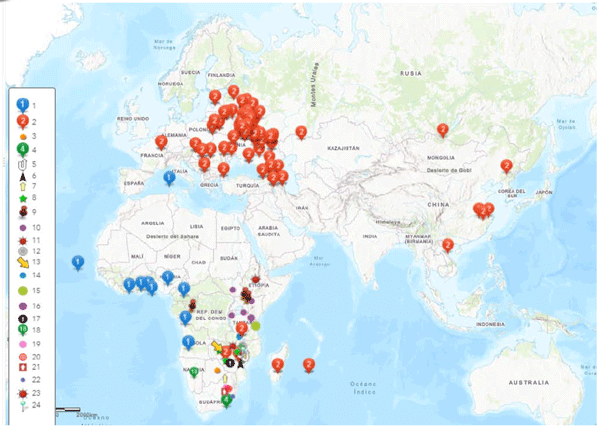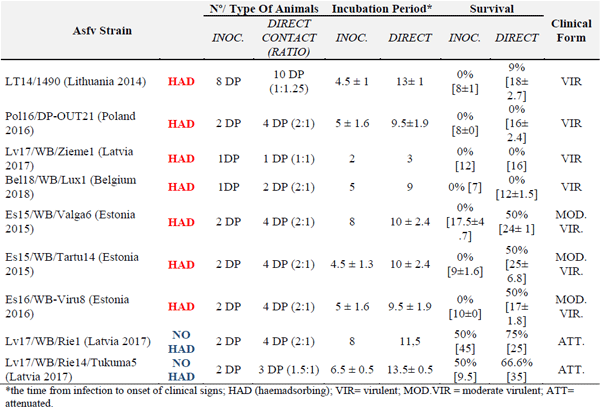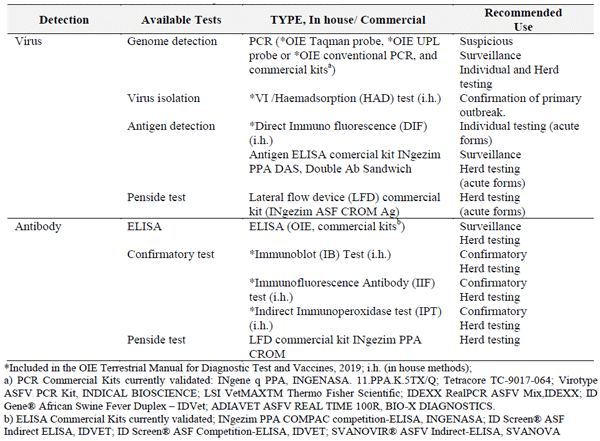African swine fever (ASF) diagnosis, an essential tool in the epidemiological investigation




Agüero M, Fernández J, Romero L, Sánchez Mascaraque C, Arias M, Sánchez-Vizcaíno JM. Highly sensitive PCR assay for routine diagnosis of African swine fever virus in clinical samples. J Clin Microbiol. 41(9):4431- 4434, 2003.
Arias M, Jurado C, Gallardo C, Fernández-Pinero J, Sánchez-Vizcaíno JM. Gaps in African swine fever: Analysis and priorities. Transbound Emerg Dis. 65 Suppl 1:235-247, 2018.
Arias M, Sánchez-Vizcaíno, JM. African swine fever eradication: The Spanish model. In: Morilla A, Jin K, Zimmerman J, editors. Trends in Emerging Viral Infections of Swine. 1. Ames, IA, USA: Iowa State University Press; pp. 133-139, 2002.
Arias M, Sánchez-Vizcaíno, JM. African swine fever In: Zimmerman, J., Karriker, L.A., Ramirez, A., Schwartz, K.J, Stevenson, G.W., Diseases of swine, 10th Edition. pp. 396-404. Editors: John Wiley and Sons, United States of America, 2012.
Bao J, Wang Q, Lin P, Liu C, Li L, Wu X, Chi T, Xu T, Ge S, Liu Y, Li J, Wang S, Qu H, Jin T, Wang Z. Genome comparison of African swine fever virus China/2018/AnhuiXCGQ strain and related European p72 Genotype II strains. Transbound Emerg Dis. May;66(3):1167-1176, 2019.
Bellini S, Rutili D, Guberti V. Preventive measures aimed at minimizing the risk of African swine fever virus spread in pig farming systems. Acta Vet Scand. 2016 Nov 29;58(1):82. Review, 2016.
Beltrán-Alcrudo D, Arias M , Gallardo C, Kramer S Penrith ML. (). African swine fever: detection and diagnosis – A manual for veterinarians. FAO Animal Production and Health Manual No. 19. Rome. Food and Agriculture Organization of the United Nations (FAO). 88p. Available at http://www.fao.org/3/a-i7228e.pdf, 2017.
Blome S, Gabriel C, Beer, M. Pathogenesis of African swine fever in domestic pigs and European wild boar. Virus Res 173(1), 122-30, 2013.
Blome S, Goller KV, Petrov A, Dräger C, Pietschmann J, Beer M. Alternative sampling strategies for passive classical and African swine fever surveillance in wild boar--extension towards African swine fever virus antibody detection. Vet Microbiol. 2014 Dec 5;174(3-4):607-608, 2014.
Boinas, FS, Hutchings, GH, Dixon, LK, Wilkinson, PJ. Characterization of pathogenic and non-pathogenic African swine fever virus isolates from Ornithodoros erraticus inhabiting pig premises in Portugal. J Gen Virol. 85(Pt 8):2177–2187, 2004.
Braae UC, Johansen MV, Ngowi HA, Rasmussen TB, Nielsen J, Uttenthal Å. Detection of African swine fever virus DNA in blood samples stored on FTA cards from asymptomatic pigs in Mbeya region, Tanzania. Transbound Emerg Dis. 2015 Feb;62(1):87-90, 2015.
Cano-Gómez C, Nieto R, Villalba A, Soler A, Pridotkas G, Arias M, Gallardo C, Fernández-Pinero J. Genomic analysis of the first African swine fever virus isolated within EU, Lithuania 2014. Proceedings of the 11th International Congress for Veterinary Virology, Vienna, Austria, 2018.
Cappai S, Rolesu S, Coccollone A, Laddomada A, Loi F. Evaluation of biological and socio-economic factors related to persistence of African swine fever in Sardinia. Prev Vet Med. 2018 Apr 1;152:1-11. 2018.
Cwynar P, Stojkov J, Wlazlak K. African Swine Fever Status in Europe. Viruses. Mar 30;11(4), 2019.
Davies K, Goatley LC, Guinat C, Netherton CL, Gubbins S, Dixon LK, Reis AL. Survival of African Swine Fever Virus in Excretions from Pigs Experimentally Infected with the Georgia 2007/1 Isolate. Transbound Emerg Dis. 2017 Apr;64(2):425-431, 2017.
European Commission (EC). African swine fever diagnostic manual (notified under document number C (2003) 1696) 2003/422/EC). Available at https://eur-lex.europa.eu/legal-content/EN/TXT/PDF/?uri=CELEX:32003D0422&from=EN. 2003.
European Commission(EC). Guidelines on surveillance and control of African swine fever in feral pigs and preventive measures for pig holdings. Available at http://ec.europa.eu/food/animal/diseases/controlmeasures/docs/sanco_7138_2013_asf_wb_en.pdf. 2013.
European Commission (EC). Animal Disease Notification System (ADNS): Outbreaks per Disease (2019). Available from: https://ec.europa.eu/food/sites/food/files/animals/docs/ad_adns_outbreaks-per-disease.pdf (Accessed: January 28, 2020). 2019.
European Food Safety Authority (EFSA). Epidemiological analyses of African swine fever in the European Union (November 2017 until November 2018). EFSA Journal 2018;16(11):5494. Available from http://onlinelibrary.wiley.com/doi/10.2903/sp.efsa.2018.EN-1521/full (Accessed: June 5, 2019). 2018a.
European Food Safety Authority (EFSA), African swine fever in wild boar. EFSA Journal 2018;16 (7):5344. Available from https://efsa.onlinelibrary.wiley.com/doi/epdf/10.2903/j.efsa.2018.5344 (Accessed: May 28, 2019). 2018b.
Fernandez-Pinero J, Gallardo C, Elizalde M, Robles A, Gomez C, Bishop R, Heath L, Couacy-Hymann E, Fasina F. O, Pelayo V, Soler A, Arias M. Molecular diagnosis of African Swine Fever by a new real-time PCR using universal probe library. Transbound Emerg Dis 60(1), 48-58, 2013.
Food and Agriculture Organization of Animal Health (FAO). Emergency Prevention System for Animal Health (EMPRES-AH): ASF situation in Asia update. Available from http://www.fao.org/ag/againfo/programmes/en/empres/ASF/situation_update.html (Accessed: February 05, 2020).
Forth JH, Tignon M, Cay AB, Forth LF, Höper D, Blome S, Beer M. Comparative Analysis of Whole-Genome Sequence of African Swine Fever Virus Belgium 2018/1. Emerg Infect Dis. Jun;25(6):1249-1252, 2019.
Fraczyk M, Wozniakowski G, Kowalczyk A, Bocian L, Kozak E, Niemczuk K, Pejsak Z. Evolution of African swine fever virus genes related to evasion of host immune response. Vet Microbiol 193, 133-44, 2016a.
Gallardo C, Fernandez-Pinero J, Pelayo V, Gazaev I, Markowska-Daniel I, Pridotkas G, Nieto R, Fernandez-Pacheco P, Bokhan S, Nevolko O, Drozhzhe Z, Perez C, Soler A, Kolvasov D, Arias M. Genetic variation among African swine fever genotype II viruses, eastern and central Europe. Emerg Infect Dis 20(9), 1544-7, 2014.
Gallardo, C, Nieto, R, Soler, A, Pelayo, V, Fernández-Pinero, J, Markowska-Daniel, I, Pridotkas, G, Nurmoja, I, Granta, R, Simón, A, Pérez, C, Martín, E, Fernández-Pacheco, P, Arias, M. Assessment of African Swine Fever Diagnostic Techniques as a Response to the Epidemic Outbreaks in Eastern European Union Countries: How To Improve Surveillance and Control Programs. J Clin Microbiol. 2015 Aug;53(8):2555-65. 2015a
Gallardo MC Reoyo AT, Fernández-Pinero J, Iglesias I, Muñoz MJ, Arias ML. African swine fever: a global view of the current challenge. Porcine Health Manag. Dec 23;1:21, 2015b.
Gallardo, C, Soler, A, Nieto, R, Sánchez, MA, Martins, C, Pelayo, V, Carrascosa, A, Revilla, Y, Simón, A, Briones, V, Sánchez-Vizcaíno, JM, Arias, M. Experimental Transmission of African Swine Fever (ASF) Low Virulent Isolate NH/P68 by Surviving Pigs. Transbound Emerg Dis. Dec;62(6):612-22, 2015c.
Gallardo C, Soler A, Nieto R, Cano C, Pelayo V, Sánchez MA, Pridotkas G,Fernandez-Pinero J, Briones V, Arias M. Experimental Infection of Domestic Pigs with African Swine Fever Virus Lithuania 2014 Genotype II Field Isolate.Transbound Emerg Dis. Feb;64(1):300-304. doi: 10.1111/tbed.12346. Epub 2015 Mar 22. PubMed PMID: 25808027. 2017.
Gallardo C, Nurmoja I, Soler A, Delicado V, Simón A, Martin E, Perez C, Nieto R, Arias M. Evolution in Europe of African swine fever genotype II viruses from highly to moderately virulent. Vet Microbiol. 2018 Jun;219:70-79. doi: 10.1016/j.vetmic.2018.04.001. Epub Apr 7, 2018.
Gallardo C, Soler A, Rodze I, Nieto R, Cano-Gómez C, Fernandez-Pinero J, Arias M. Attenuated and nonhaemadsorbing (non-HAD) genotype II African swine fever virus (ASFV) isolated in Europe, Latvia 2017. Transbound Emerg Dis. 2019 May;66(3):1399-1404, 2019a.
Gallardo C, Fernández-Pinero J, Arias M. African swine fever (ASF) diagnosis, an essential tool in the epidemiological investigation.(2019b). Virus Res. 2019 Oct 2;271:197676. doi: 10.1016/j.virusres.2019.197676. Epub 2019 Jul 27. Review. PubMed PMID: 31362027, 2019b.
Garigliany M, Desmecht D, Tignon M, Cassart D, Lesenfant C, Paternostre J, Volpe R, Cay AB, van den Berg T, Linden A Phylogeographic Analysis of African Swine Fever Virus, Western Europe, 2018. Emerg Infect Dis. Jan;25(1):184-186, 2019.
Ge S, Li J, Fan X, Liu F, Li L, Wang Q, Ren W, Bao J, Liu C, Wang H, Liu Y, Zhang Y, Xu T, Wu X, Wang Z. Molecular Characterization of African Swine Fever Virus, China, 2018. Emerg Infect Dis. Nov;24(11):2131-2133, 2018.
Gonzague M, Roger F, Bastos A, Burger C, Randriamparany T, Smondack S, Cruciere C. Isolation of a nonhaemadsorbing, non-cytopathic strain of African swine fever virus in Madagascar. Epidemiol Infect. 2001 Jun;126(3):453-9. PubMed PMID: 11467803; PubMed Central PMCID: PMC2869714.
Grau FR, Schroeder ME, Mulhern EL, McIntosh MT, Bounpheng MA. Detection of African swine fever, classical swine fever, and foot-and-mouth disease viruses in swine oral fluids by multiplex reverse transcription real-time polymerase chain reaction. J Vet Diagn Invest. 2015 Mar;27(2):140-9, 2015.
Guinat C, Reis AL, Netherton CL, Goatley L, Pfeiffer DU, Dixon L. Dynamics of African swine fever virus shedding and excretion in domestic pigs infected by intramuscular inoculation and contact transmission. Vet Res. 2014 Sep 26;45:93. 2014.
Guinat C, Gubbins S, Vergne T, Gonzales JL, Dixon L, Pfeiffer DU. Experimental pig-to-pig transmission dynamics for African swine fever virus, Georgia 2007/1 strain. Epidemiol Infect 144(1), 25-34, 2016.
Iglesias I, Rodriguez A, Feliziani F, Rolesu S, de la Torre A. Spatio-temporal Analysis of African Swine Fever in Sardinia (2012-2014): Trends in Domestic Pigs and Wild Boar. Transbound Emerg Dis 64(2), 656-662, 2017.
Jurado C, Fernández-Carrión E, Mur L, Rolesu S, Laddomada A, Sánchez-Vizcaíno JM. Why is African swine fever still present in Sardinia? Transbound Emerg Dis. Apr; 65(2):557-566, 2018a.
Jurado C, Martínez-Avilés M, De La Torre A, Štukelj M, de Carvalho Ferreira HC, Cerioli M, Sánchez-Vizcaíno JM, Bellini S. Relevant Measures to Prevent the Spread of African Swine Fever in the European Union Domestic Pig Sector. Front Vet Sci. Apr 16;5:77, 2018b.
Kim HJ, Cho KH, Lee SK, Kim DY, Nah JJ, Kim HJ, Kim HJ, Hwang JY, Sohn HJ, Choi JG, Kang HE, Kim YJ. Outbreak of African swine fever in South Korea, 2019. Transbound Emerg Dis. 2020 Jan 19. doi: 10.1111/tbed.13483. [Epub ahead of print] PubMed PMID: 31955520, 2019.
King DP, Reid SM, Hutchings GH, Grierson SS, Wilkinson PJ, Dixon LK, Bastos AD, Drew TW. Development of a TaqMan PCR assay with internal amplification control for the detection of African swine fever virus. J Virol Methods. 107(1):53-61, 2003.
Laddomada A, Rolesu S, Loi F, Cappai S, Oggiano A, Madrau MP, Sanna ML, Pilo G, Bandino E, Brundu D, Cherchi S, Masala S, Marongiu D, Bitti G, Desini P,Floris V, Mundula L, Carboni G, Pittau M, Feliziani F, Sanchez-Vizcaino JM, Jurado C, Guberti V, Chessa M, Muzzeddu M, Sardo D, Borrello S, Mulas D, Salis G, Zinzula P, Piredda S, De Martini A, Sgarangella F. 2019. Surveillance and control of African Swine Fever in freeranging pigs in Sardinia. Transbound Emerg Dis. May;66(3):1114-1119, 2019.
Le VP, Jeong DG, Yoon SW, Kwon HM, Trinh TBN, Nguyen TL, Bui TTN, Oh J, Kim JB, Cheong KM, Van Tuyen N, Bae E, Vu TTH, Yeom M, Na W, Song D. Outbreak of African Swine Fever, Vietnam, 2019. Emerg Infect Dis. 2019 Jul;25(7):1433-1435. doi: 10.3201/eid2507.190303. Epub 2019 Jul 17. PubMed PMID: 31075078; PubMed Central PMCID: PMC6590755.
Leitão A, Cartaxeiro C, Coelho R, Cruz B, Parkhouse RM, Portugal F, Vigário JD Martins CL. The nonhaemadsorbing African swine fever virus isolate ASFV/NH/P68 provides a model for defining the protective anti-virus immune response. J Gen Virol. Mar;82(Pt 3):513-23, 2001.
Malogolovkin A, Yelsukova A, Gallardo C, Tsybanov S, Kolbasov D. Molecular characterization of African swine fever virus isolates originating from outbreaks in the Russian Federation between 2007 and 2011. Vet Microbiol 158(3-4), 415-419, 2012.
Mazur-Panasiuk N, Woźniakowski G. The unique genetic variation within the O174L gene of Polish strains of African swine fever virus facilitates tracking virus origin. Arch Virol. Jun;164(6):1667-1672, 2019a.
Mazur-Panasiuk N, Woźniakowski G, Niemczuk K.. The first complete genomic sequences of African swine fever virus isolated in Poland. Sci Rep. 2019b Mar 14;9(1):4556, 2019b.
Michaud V, Gil P, Kwiatek O, Prome S, Dixon L, Romero L, Le Potier MF, Arias M, Couacy-Hymann E, Roger F, Libeau G, Albina E. Long-term storage at tropical temperature of dried-blood filter papers for detection and genotyping of RNA and DNA viruses by direct PCR. J Virol Methods. 2007 Dec;146(1-2):257-65, 2007
Mulumba-Mfumu LK, Saegerman C, Dixon LK, Madimba KC, Kazadi E, Mukalakata NT, Oura CAL, Chenais E, Masembe C, Ståhl K, Thiry E, Penrith ML. African swine fever: Update on Eastern, Central and Southern Africa. Transbound Emerg Dis. 2019 Mar 28, 2019.
Mur L, Gallardo C, Soler A, Zimmermman J, Pelayo V, Nieto R, Sánchez-Vizcaíno JM, Arias M. Potential use of oral fluid samples for serological diagnosis of African swine fever. Vet Microbiol. 2013 Jul 26;165(1-2):135-9, 2013.
Mebus, CA, Dardiri, AH. Western Hemisphere Isolates of African Swine Fever Virus: Asymptomatic Carriers and Resistance to Challenge Inoculation. Am J Vet Res, Vo, 41 (11), 1867-1869, 1980.
Moulton, J, Coggins, L. Comparison of lesions in acute and chronic African swine fever. Cornell Vet. Jul;58(3):364-88, 1968.
Nieto R, Soler A, Nurmoja I, Pelayo V, Pridotkas G, Rozde I, Andrzej K, Markowska DI, Pérez C, Simón A, Martín E, Fernandez-Pinero J, Arias M, Gallardo C. Molecular Characterization of African swine fever virus (ASFV) isolates circulating in the Eastern European Union countries 2014-2016. In proceedings of the EPIZONE 10th Annual Meeting 2016, Madrid, Spain, 2016.
Nurmoja, I, Petrov A, Breidenstein, C, Zani, L, Forth JH, Beer M, Kristian M, Viltrop A, Blome, S. Biological characterization of African swine fever virus genotype II strains from north-eastern Estonia in European wild boar. Transbound Emerg Dis. Jan 24, 2017
Oura CA, Edwards L, Batten CA. Virological diagnosis of African swine fever--comparative study of available tests. Virus Res. Apr;173(1):150-8, 2013. Review.
Olesen AS, Lohse L, Dalgaard MD, W oźniakowski G , B elsham GJ, B øtner A , R asmussen T B. (). Complete genome sequence of an African swine fever virus (ASFV POL/2015/Podlaskie) determined directly from pig erythrocyte-associated nucleic acid. J Virol Methods. Nov; 261:14-16, 2018.
Petrov A, Schotte U, Pietschmann J, Dräger C, Beer M, Anheyer-Behmenburg H, Goller KV, Blome S. Alternative sampling strategies for passive classical and African swine fever surveillance in wild boar. Vet Microbiol. 2014 Oct 10;173(3-4):360-5, 2014.
Pikalo J, Zani L, Hühr J, Beer M, Blome S. (). Pathogenesis of African swine fever in domestic pigs and European wild boar - lessons learned from recent animal trials. Virus Res. 2019 Apr 3. 2019.
Pini A. Isolation and segregation of non-haemadsorbing strains of African swine fever virus. Vet Rec. Dec 11;99(24):479-80, 1976
Quembo CJ, Jori F, Vosloo W, Heath L. Genetic characterization of African swine fever virus isolates from soft ticks at the wildlife/domestic interface in Mozambique and identification of a novel genotype. Transbound Emerg Dis. 2018 Apr;65(2):420-431, 2018.
Randriamparany T, Kouakou KV, Michaud V, Fernández-Pinero J, Gallardo C, Le Potier MF, Rabenarivahiny R, Couacy-Hymann E, Raherimandimby M, Albina E. African Swine Fever Diagnosis Adapted to Tropical Conditions by the Use of Dried-blood Filter Papers. Transbound Emerg Dis. 2016 Aug;63(4):379-88, 2016.
Rowlands RJ, Michaud V, Heath L, Hutchings G, Oura C, Vosloo W, Dwarka R, Onashvili T, Albina E, Dixon LK. African swine fever virus isolate, Georgia, 2007. Emerg Infect Dis 14(12), 1870-4, 2008.
Sánchez-Cordón PJ, Chapman D, Jabbar T, Reis AL, Goatley L, Netherton CL, Taylor G, Montoya M, Dixon L. Different routes and doses influence protection in pigs immunised with the naturally attenuated African swine fever virus isolate OURT88/3. Antiviral Res. Feb;138:1-8, 2017.
Sánchez EG, Pérez-Núñez D, Revilla Y. Development of vaccines against African swine fever virus. Virus Res. 265:150-155, 2019.
Sánchez-Vizcaíno, JM, Mur L, Gomez-Villamandos, JC, Carrasco, L. An update on the epidemiology and pathology of African swine fever. J Comp Pathol. Jan;152(1):9-21, 2015.
Sargsyan MA, Voskanyan HE, Karalova EM, Hakobyan LH, Karalyan ZA. Third wave of African swine fever infection in Armenia: Virus demonstrates the reduction of pathogenicity. Vet World. 2018 Jan;11(1):5-9, 2018
Sastre P, Gallardo C, Monedero A, Ruiz T, Arias M, Sanz A, Rueda P. Development of a novel lateral flow assay for detection of African swine fever in blood. BMC Vet Res. 12:206. 2016.
Thomson GR, Gainaru MD, van Dellen AF. African swine fever: pathogenicity and immunogenicity of two nonhaemadsorbing viruses. Onderstepoort J Vet Res. 46(3):149-54, 1979.
World Organisation for Animal Health (OIE). African swine fever. In: Manual of diagnostic tests and vaccines for terrestrial animals 2019; Vol 2, Chapter 3.8.1. http://www.oie.int/fileadmin/Home/eng/Health_standards/tahm/3.08.01_ASF.pdf. 2019.
Zani L, Forth JH, Forth L, Nurmoja I, Leidenberger S, Henke J, Carlson J, Breidenstein C, Viltrop A, Höper D, Sauter-Louis C, Beer M, Blome S. Deletion at the 5'-end of Estonian ASFV strains associated with an attenuated phenotype. Sci Rep. Apr 25;8(1):6510, 2018.
Zhao D, Liu R, Zhang X, Li F, Wang J, Zhang J, Liu X, Wang L, Zhang J, Wu X, Guan Y, Chen W, Wang X, He X, Bu Z. Replication and virulence in pigs of the first African swine fever virus isolated in China. Emerg Microbes Infect. 2019;8(1):438-447, 2019.







